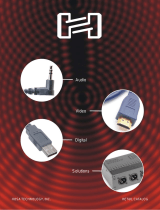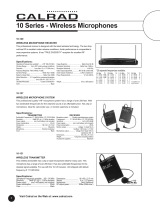Page is loading ...

www.SnapAV.com
140310-0950 Copyright © 2014 Binary™ Cables
Application Guide
Which Speaker Cable Should I Use?
Use these guidelines and charts to help choose the best speaker cable for your next job. See the Speaker Cable Basics sec-
tion on the next page for more detailed descriptions of cable features and specications.
General Considerations
• Installation Environment — Use direct burial rated exterior cable for runs that will be exposed to the elements or buried in
the ground. Use CL2 rated cable for indoor runs inside the wall and ceiling.
• Choose the Right Packing — Consider where you will have to transport the cable and how it will be used. If it has to be
carried up several oors by hand, lightweight nest boxes may be the best option. Spools of cable, however, can provide an
advantage over nest boxes since they can be organized on a wire cart or pulling system for easier installation.
• Conductor Gauge & Strand Count — Higher strand-count conductors transmit frequencies more accurately. Larger wire
gauge causes less power loss over a longer distance.
Speaker Cable Selection for Home Theater
• All speakers should be paired appropriately and installed so that audio will be balanced well around the listening area.
Make sure that cable can be routed to every planned location.
• Size the wire based on the longest single run to a speaker, and use the same wire gauge for every speaker run. Changing
the type of cable between speakers can cause noticeable differences in audio quality.
• Plan for the least amount of loss possible. Home theater sound quality depends on accurate reproduction. Most systems
will need at least 16 AWG conductors for little to no loss. A system with 50% loss will never sound as good as a system
with under 11% loss.
Speaker Cable Selection for Multi-Room and Outdoor Audio
• Before selecting wire, decide on either 70 volt or 4/8Ω speakers. For a couple of speakers in the dining and living room, a
4/8Ω system may be perfect, but many large applications with a lot of speakers would benet from a 70 volt system. More
speakers can run on one amplier and smaller wire can be used with less power loss.
• Most multi-room systems have more than one speaker connected to one output. Calculate the wire size for these runs
based on the total distance from the output to the farthest speaker. Use the same wire gauge and type between all speak-
ers in the run.
Wire Distance Power Loss Chart
Use this chart to determine the wire size (AWG) needed for the cable length used. Then, select the best cable product avail-
able in that size using the Cable Type Chart on the next page.
Power Loss % / Attenuation (dB)
4Ω Speaker (or 2 8Ω in parallel) 8Ω Speaker 70 Volt Speaker
Wire Size
(AWG)
11%
0.5dB
21%
1.0dB
37%
2.0dB
50%
3.0dB
11%
0.5dB
21%
1.0dB
37%
2.0dB
50%
3.0dB
11%
0.5dB
21%
1.0dB
37%
2.0dB
50%
3.0dB
12 143 311 680 1173 291 622 1352 2331 6782 14592 31830 54880
14 92 199 437 755 189 403 876 1510 4400 9457 19473 33574
16 61 128 278 479 117 255 553 954 2783 5978 13045 22491
18 41 92 201 347 87 194 405 699 2029 4361 9504 16386
20 26 51 115 199 51 107 231 398 1147 2470 5400 9310
22 15 36 80 138 36 71 163 281 804 1735 3780 6517
These values represent how many feet of wire can be run before signal at the speaker exceeds the listed amount of loss.

www.SnapAV.com
140310-0950 Copyright © 2014 Binary™ Cables
Application Guide
Wire Size
(AWG / # of conductors)
Indoor - Spool Indoor - Nested Box Outdoor - Spool
18/2 SP-182-DB-1000-BLK
18/4 SP-184-DB-1000-BLK
16/2
SP-162-500-WH NST-162-1000-WH SP-162-DB-500-BLK
SP-162-500-BLK NST-162-1000-BLK
SP-162-500-BLU NST-162-500-WH
NST-162-500-BLK
NST-162-500-BLU
NST-162-LS-500-WHT
NST-162-LS-500-BLK
16/4
SP-164-500-WH NST-164-500-WH SP-164-DB-500-BLK
SP-164-500-BLK NST-164-500-BLK
SP-164-500-PU NST-164-500-PU
NST-164-LS-500-WHT
NST-164-LS-500-BLK
14/2
SP-142-500-WHT SP-142-DB-500-BLK
SP-142-500-BLK
14/4
SP-144-500-WHT SP-144-DB-500-BLK
SP-144-500-BLK
Speaker Cable Basics
• Conductor Size (AWG) — The gauge of the conductor (AWG) is the effective diameter of the copper inside the insulation.
The smaller the number, the bigger the diameter. 12AWG is larger than 14AWG. The longer the run is, the bigger the wire
must be to maintain a sufcient power level.
• Strand Count — Strand count is the number of strands of copper that make up the conductor size described above. Two
different 14AWG conductors with different strand counts are not equal in performance. The higher count cable will conduct
speaker level audio signal much more efciently than the lower strand count, resulting in better quality audio reproduction.
• Conductor Quantity — The number of conductors in the wire dictates how many audio channels may be carried. Every
pair of conductors carries one channel of audio. Use 2-conductor cable to carry 1-channel audio. Use 4-conductor to carry
2-channel audio (like left and right for stereo).
• Jacket Type — Jacket types change to allow installation of the cable in special environments. Most cable is only rated for
use in spaces where no air travels that could enter the occupied parts of the building. Special jackets are made to allow
direct burial/outdoor use, plenum use, or for other special situations. Make sure that specially rated cables have markings
left visible for inspection by local code enforcement.
• Packaging and Length — Speaker wire is sold in nest boxes and on spools in a box. Nest boxes are lighter-weight, and
are typically cheaper. Spool boxes are heavier duty so they cost more than nest boxes. Spools can be used with carts or
racks that make cable storage easier. Most cable is limited to 500 or 1000 feet in a package.
• Naming System — Examples— 18/2, 14/2, 14/4... The rst number is the size of each conductor in AWG gauge. The
second number is the total number of conductors inside the outer jacket. 18/2 means the wire has 2 individually insulated
18AWG conductors inside. 18/4 has 4 conductors inside. If there is a sufx it may indicate the cable has a special quality
for use in certain environments. See ‘Jacket Types’ above.
Wire Type Chart
This chart lists the model number of each cable type Binary™ offers. Find the compatible type by using the legend on the left.
This chart will be updated regularly as new cable types become available.
/

